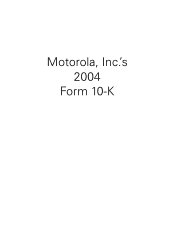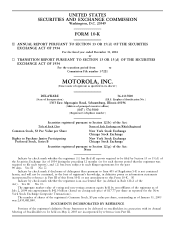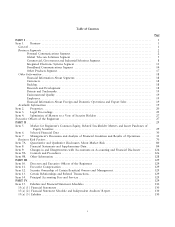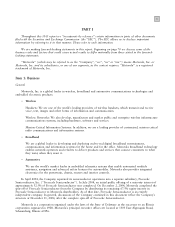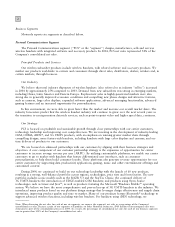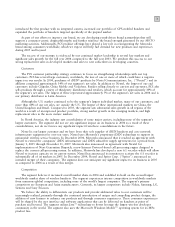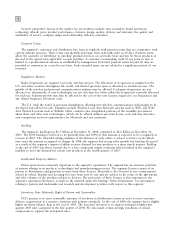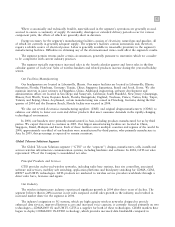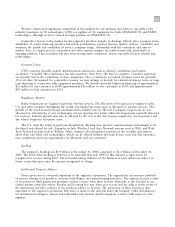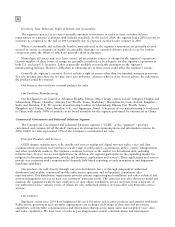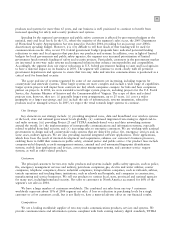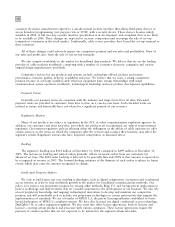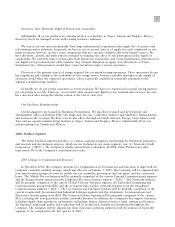Motorola 2004 Annual Report Download - page 15
Download and view the complete annual report
Please find page 15 of the 2004 Motorola annual report below. You can navigate through the pages in the report by either clicking on the pages listed below, or by using the keyword search tool below to find specific information within the annual report.
7
We have experienced signiÑcant competition in the markets for our products and services, especially as the
industry transitions to 3G technologies. GTSS is a supplier of 3G equipment for both CDMA2000 1X and UMTS
technologies, although we have a much stronger position in CDMA2000 1X.
Competitive factors in the market for the segment's products include: technology oÅered; price; payment terms;
availability of vendor Ñnancing; product and system performance; product features, quality, delivery, availability and
warranty; the quality and availability of service; company image; relationship with key customers; and time-to-
market. Price is a major area of competition and often impacts margins for initial system bids, particularly in
emerging markets. Time-to-market has also been an important competitive factor, especially for new systems and
technologies.
Payment Terms
GTSS contracts typically include implementation milestones, such as delivery, installation and system
acceptance. Generally, these milestones can take anywhere from 30 to 180 days to complete. Customer payments
are typically tied to the completion of these milestones. Once a milestone is reached, payment terms are generally
30 to 60 days. As required for competitive reasons, we may arrange or provide for extended payment terms or long-
term Ñnancing in connection with equipment purchases. We directly provided long-term Ñnancing of approximately
$23 million to one customer in 2004; approximately $16 million to two customers in 2003; and approximately
$47 million to four customers in 2002.
Regulatory Matters
Radio frequencies are required to provide wireless services. The allocation of frequencies is regulated in the
U.S. and other countries throughout the world, and limited spectrum space is allocated to wireless services. The
growth of the wireless and personal communications industry may be aÅected if adequate frequencies are not
allocated or, alternatively, if new technologies are not developed to better utilize the frequencies currently allocated
for such use. Industry growth may also be aÅected by the cost of the new licenses required to use frequencies and
any related frequency relocation costs.
The U.S. leads the world in spectrum deregulation, allowing new wireless communications technologies to be
developed and oÅered for sale. Examples include Wireless Local Area Network systems such as WiFi, and Wide
Area Network systems such as WiMax. Other countries also deregulated portions of the available spectrum to
allow these and other new technologies, which can be oÅered without spectrum license costs and may introduce
new competition and new opportunities for Motorola and our customers.
Backlog
The segment's backlog was $1.9 billion at December 31, 2004, compared to $1.6 billion at December 31,
2003. The 2004 order backlog is believed to be generally Ñrm and 100% of that amount is expected to be
recognized as revenue during 2005. The forward-looking estimates of the Ñrmness of such orders are subject to
future events that may cause the amount recognized to change.
Intellectual Property Matters
Patent protection is extremely important to the segment's operations. The segment has an extensive portfolio
of patents relating to its products, systems, technologies, and manufacturing processes. The segment licenses certain
of its patents to third parties and generates modest revenue from these licenses. Motorola is also licensed to use
certain patents owned by others. Royalty and licensing fees vary from year to year and are subject to the terms of
the agreements and sales volumes of the products subject to licenses. The protection of these licenses is also
important to the segment's operations. Reference is made to the material under the heading ""Other Information''
for information relating to patents and trademarks and research and development activities with respect to this
segment.


